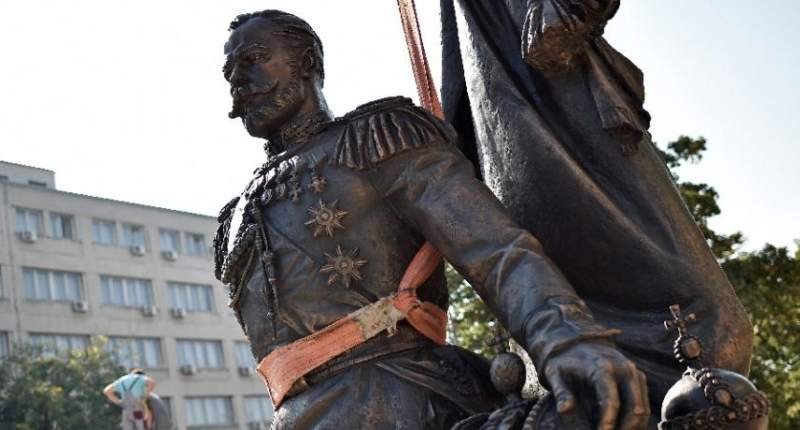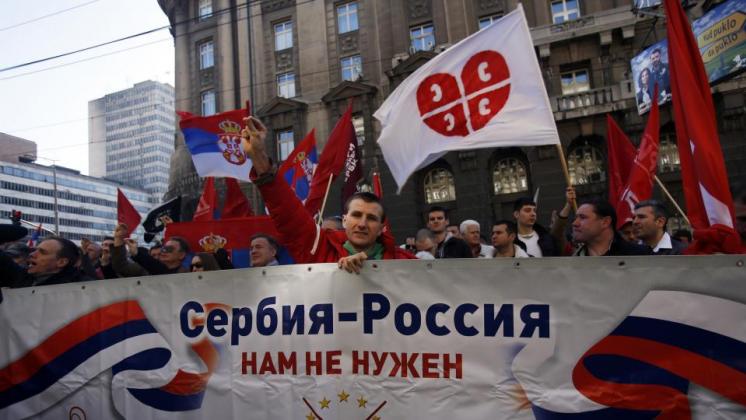
Views: 900

A strange spy affair broke out in Balkan Casablanca, aka Serbia, on Wednesday. Were NATO “advisers” and liaison personnel embedded in the Serbian army command finally caught red-handed by vigilant Serbian counter-intelligence operatives, purloining secrets? Not this time. (Something along those lines actually did happen in 2002; it was when former armed forces chief of staff Momcilo Perisic was caught on camera in a Belgrade restaurant handing over secret information for cash to CIA’s Johnny-on-the-spot, John Neighbor.) But what allegedly occurred this time was not a boring rerun of the Perisic affair, although the basic contours of the unimaginative scenario are remarkably similar. The Perisic fiasco was simply reverse engineered, with the bad guys this time being not “all the usual suspects” but their current geopolitical adversaries and rivals for predominant influence in the Balkan swamp.
In short, former Russian deputy military attaché in Serbia, Georgy Kleban, stands accused of suborning a Serbian official, for the moment identified only as “Z. K,” in the parking lot of another Belgrade restaurant. But while the Perisic affair was rather clean-cut, what in America they call “an open and shut case,” its current copy-cat has been rather convoluted from the beginning. For one thing, it does not seem that it was Serbia’s diligent counter spies who broke the case. There is no footage of Serbian security officials triumphantly announcing their latest foreign spy catch, or of stern government officials vowing to protect their state secrets and country’s sovereignty. Humiliatingly, the scandal broke with a media release by the Serbian service of Radio Free Europe, banally headlined “Russian intelligence officer’s meeting with a ‘Serbian agent’ in Belgrade.” (Conspiracy theorists should take no heart from this because we are assured by RFE Boy Scouts on their website that “in 1971, all CIA involvement ended.”) The RFE story went viral in a matter of hours. The drumbeat was quickly picked up by Ringier-owned “Blitz” in Belgrade and who-knows-by-whom-owned “Guardian” in London. The newsprint production was accompanied by a 2:41 minute video, helpfully captioned “RUSSIAN INTELLIGENCE OFFICER MEETING SERBIAN SPY – WATCH THIS”, which has so far registered a respectable 230,000 views.
It should be pointed out that if Serbs were meant to be the video’s primary target audience, the so far anonymous production did not exactly get rave reviews. One local internet portal commentator realistically noted one of its obvious culturological deficiencies: “That in the middle of Belgrade someone should leave a bag full of cash in his car and go to a restaurant… Unreal…” On another portal, a reader chimed in: “Is it conceivable that anyone would publish such baloney? Russians paying Serbian officers for intelligence information… Dear God, what nonsense! The great majority of the Serbian people would hand that information to the Russians for free. They take money only from Anglo-Saxons.” General Perisic proved that point. As they say, Vox populi, vox Dei.
Admittedly, the production values of the incriminating video are dismal. But even more importantly, several questionable background details surfaced almost instantly. The video had not been shot recently, but in December of 2018. So, as a minimum, someone has been sitting on this explosive information about Russian intelligence skullduggery for an inexplicably long time, perhaps waiting for just the right moment to release it. The other pertinent detail that emerged was about the involvement of the British outfit Bellingcat in allegedly identifying one of the protagonists (or actors) as the Russian assistant military attaché, using sophisticated face recognition equipment.
At this point a pause for reflection is in order. Bellingcat rings a bell. Yes, it is the same “citizen intelligence” organization that in 2013 fabricated data to implicate the Syrian government in the Ghoutta chemical attack. After that, it actively promoted Russia’s involvement in the shooting down of MH17 over the Donbass, and played a vociferous media role in the purported identification of two Russians on a visit to England as GRU agents sent to paint with a lethal poison the doorknob of the Skripal residence in Salisbury.
And here the Salisbury analogies with the Belgrade affair become “curiouser and curiouser,” as the inimitable wordsmith Alice in Wonderland would have put it. Like the hapless Lt. Col. Kleban, the Salisbury duo were said to have been identified by Bellingcat using cutting-edge face recognition technology. Kleban’s incriminating links to GRU were supposedly established by Bellingcat using similar techniques to those applied in the Salisbury case, widely touted as “highly likely” at the time. Mrs. Kleban’s address was discovered by expert sleuthing to be a building in Russia used by the country’s special forces (extremely odd for a military family!) which, in turn, by creative reasoning was further affiliated with the GRU.
So we have got here not just an inverted mirror image of the Perisic spy scandal, with a reversed assignment of roles, but a pathetic failure of imagination as well, which MI6 chief Alex Younger would have been wiser not to publicly praise. Does anyone seriously believe that after a mere citizens’ outfit like Bellingcat so easily unmasked their Salisbury agents by linking them to tell-tale residences in Russia, GRU’s seasoned spy chiefs would have been so negligent as not to happily pay for Mrs. Kleban’s moving expenses to a less compromising address?
Oh, yes, and “hiding in plain sight,” to use a phrase that Bellingcat’s founder Eliot Higgins seems to be fond of, there are a couple of things. No one knows who made the supposedly incriminating video and under what ingenious circumstances, no one can say for sure what exactly “Z. K.” gave to the person said to be Kleban in a paper bag (was it a bottle of vodka, or perhaps slivovitz?), the video was uploaded on YouTube by anonymous actors, and it shows none of the expected time/date markings. The video is a Rorschach image to which everyone can attribute the significance he was preconditioned to read into it. And last but not least, the editing job was appalling.
As for the timing, it suffices to note that speculation about Serbia’s impending purchase of Russian military equipment, particularly air defense systems, has aroused consternation in certain quarters. So undoubtedly has Serbia’s recent signing of a trade treaty with the Eurasian Union, to mention just a couple of irritants. Predrag Petrović of the Belgrade Center for Security Policy adds more compelling elements to the timing hypothesis by pointing out “a number of possibilities for the video’s origin, including a public signal to Serbia over Russian infiltration from western intelligence agencies, or a setup by the government to distract attention from a recent scandal involving arms trafficking.”
As for where this spy thriller was “highly likely” concocted and why, we can safely leave that to the readers, who probably have more imagination than Bellingcat’s scenarists.

Originally published on 2019-11-23
About the author: Stephen Karganovic is the President of the Srebrenica Historical Project.
Origins of images: Facebook, Twitter, Wikimedia, Wikipedia, Flickr, Google, Imageinjection, Public Domain & Pinterest.
Read our Disclaimer/Legal Statement!
Donate to Support Us
We would like to ask you to consider a small donation to help our team keep working. We accept no advertising and rely only on you, our readers, to keep us digging the truth on history, global politics and international relations.
[wpedon id=”4696″ align=”left”]









